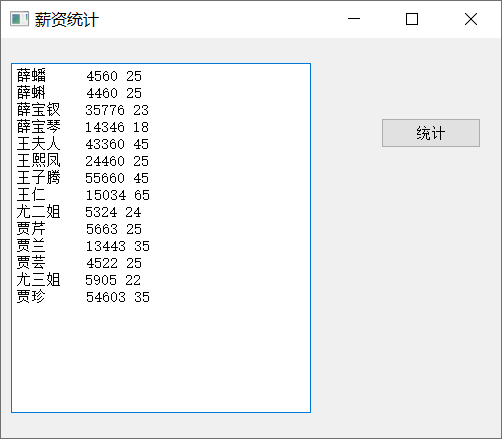Foreword Original article:https://www.byhy.net/tut/py/gui/qt_02/
1. Start with an example Now let’s develop a program that lets the user enter a text containing:Employee name, salary, and age.
The format is as follow:
1 2 3 4 5 6 7 8 9 10 11 12 13 14 薛蟠 4560 25
The program can print out the list of people with salaries above and below 20,000.
Of course, we can do the same as before, and develop a command line program, and let the user type on the character terminal.
But it would be even cooler if we could develop a graphical interface program like the following.
In fact, with PySide2, this short program is all you need to develop the interface above
1 2 3 4 5 6 7 8 9 10 11 12 13 14 15 16 17 18 19 20 from PySide2.QtWidgets import QApplication, QMainWindow, QPushButton, QPlainTextEdit500 , 400 )300 , 310 )'薪资统计' )"请输入薪资表" )10 , 25 )300 , 350 )'统计' , window)380 , 80 )
2. Interfae action processing (Signal and Slot) When the user clicks the statistics button, the user input string content is obtained from the interface contorl QPlainTextEdit for processing.
But how to you notify the program when the user clicks the statistics button? Only if the program is notify of the click can it do anything about it.
In fact, QT use Signal and Slot to achieve this association.
We can define a function as follows:
1 2 def handleCalc ():print ('统计按钮被点击了' )
Then, specify that if a button is clicked, you need handleCalc to handle it, like this:
1 button.clicked.connect(handleCalc)
After our modification, the code is as follow:
1 2 3 4 5 6 7 8 9 10 11 12 13 14 15 16 17 18 19 20 21 22 23 24 25 26 27 28 29 30 31 32 33 34 35 36 37 38 39 40 41 42 43 44 45 46 47 from PySide2.QtWidgets import QApplication, QMainWindow, QPushButton, QPlainTextEdit, QMessageBoxdef handleCalc ():'' '' for line in info.splitlines():if not line.strip():continue ' ' )for p in parts if p]if int (salary) >= 20000 :'\n' else :'\n' '统计结果' ,f'''薪资20000 以上的有:\n{salary_above_20k} \n薪资20000 以下的有:\n{salary_below_20k} ''' 500 , 400 )300 , 300 )'薪资统计' )"请输入薪资表" )10 , 25 )300 , 350 )'统计' , window)380 , 80 )
When you run it, you’ll find the following results:
3. Encapsulate into a class The code above treats all the variable names corresponding to the control as global variable.
If you were to design a slightly more complex program, you would have too many variable names for the controls.
It’s also bad for modularity.
Therefore, we should usually warp a windo and its contained controls, the corresponding code all into the class, as shown below.
1 2 3 4 5 6 7 8 9 10 11 12 13 14 15 16 17 18 19 20 21 22 23 24 25 26 27 28 29 30 31 32 33 34 35 36 37 38 39 40 41 42 43 44 45 46 47 48 49 from PySide2.QtWidgets import QApplication, QMainWindow, QPushButton, QPlainTextEdit, QMessageBoxclass Stats ():def __init__ (self ):self .window = QMainWindow()self .window.resize(500 , 400 )self .window.move(300 , 300 )self .window.setWindowTitle('薪资统计' )self .textEdit = QPlainTextEdit(self .window)self .textEdit.setPlaceholderText("请输入薪资表" )self .textEdit.move(10 , 25 )self .textEdit.resize(300 , 350 )self .button = QPushButton('统计' , self .window)self .button.move(380 , 80 )self .button.clicked.connect(self .handleCalc)def handleCalc (self ):self .textEdit.toPlainText()'' '' for line in info.splitlines():if not line.strip():continue ' ' )for p in parts if p]if int (salary) >= 20000 :'\n' else :'\n' self .window,'统计结果' ,f'''薪资20000 以上的有:\n{salary_above_20k} \n薪资20000 以下的有:\n{salary_below_20k} '''

